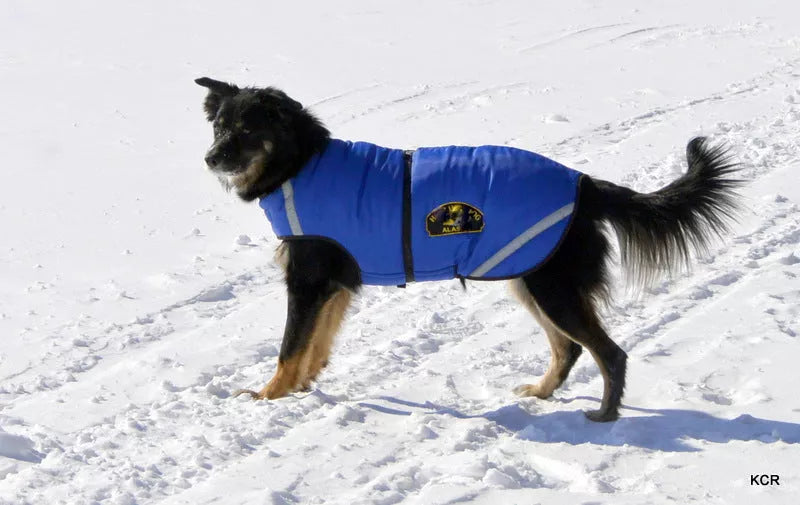Which is The Best Winter Coat For My Dog

As the winter gets into full swing, you might sensibly decide that it’s time to get your dog a coat to keep them warm and dry during periods of inclement weather.
Fortunately, there is much more choice available nowadays and you can easily find a good product either at your local pet shop or online. Deciding which kind of coat will depend on the type and size of your dog and what you want it to be used for.
For instance, if you want your dog to walk down the street with a little style then you may well be less interested in the material than the actual look.
Most owners though want to keep their dogs warm and dry, particularly if the animal has short hair.
Some dogs tend to suffer from the cold including breeds like greyhounds, small dogs, older animals or those that have an illness. If we are talking about outdoor coats, there are three weather elements that you'll want to provide protection against:
Wind:
A strong breeze or even a full blown gale can make it seem a lot colder than normal so a coat that has a wind resistant layer combined with something like a woollen fleece is ideal.
Some fabrics are better than others when it comes to keeping the wind out so you'll want to go with a tighter knit, breathable fabric wherever possible.
Cold:
The winter months can be reasonably warm, but you can bet a cold snap is just around the corner.
Again, a synthetic polyester fleece or similar coat material is perfect for protecting your dog and keeping them snug. Even a t-shirt as a base layer can be a very welcome addition under a jumper or warmer outer layer.
Wet:
Of course, it’s always going to rain and at certain times of the year it can seem relentless. Just like humans, when dogs get wet it seems a whole lot colder.
The best type of coat is one that provides a shield from the rain but also keeps your furry friend warm. A polar fleece is again a good fabric as it absorbs very little water and a coat with a decent waterproof fabric will keep almost all of the wet off your dog's fur and skin.
Winter means that many of us have to take that evening walk when it’s dark and cold. Options such as reflective material and flashing LED lit piping will make sure that you and your dog are seen properly at night. Some of these coats run on cell batteries or embedded power packs which can be recharged via a USB lead or even a solar panel - things have certainly moved on in this area. Some high vis coats are not fully waterproof but the casing around any light source usually is.
Choosing the best coat for your dog is a combination of what's fashionable, fits well and does the job. Most dog coats on the market today come with a protective layer over something which insulates and these are very easy to maintain.
To clean them you simply put the coat into the washing machine on a suitable eco-cycle or lower temperature wash. However, if you have long haired dogs, you might find that excessive hair coming off the coat will clog the washing machine. In these cases you can just as easily hand wash the item with a non-biological powder.
Search around and you should be able to find a bargain or two out there and, on the whole, coats don’t usually cost the earth. It’s a good idea to check the reviews to see if there are any problems with a particular product, such as not being particularly hardy or if dogs find them uncomfortable to wear.
Measuring your dog for a coat is usually pretty simple and most suppliers will offer dimensions to include:
The topline - a measurement from the shoulder blades (at the back of the neck) down to the base of the tail.
The girth - the area around the chest, usually the widest part of the ribcage.
The neck - usually where the collar sits.
The majority of coats have some room for adjustment and supply buttons or velcro fastenings that can be altered for the dog’s comfort and security. Whatever you go for, there’s no doubt a good coat can make your next dog walk a more pleasurable experience.
Take a look at our range of waterproof dog coat with underbelly protection here.
Andy, Wiggles and Wags
Fortunately, there is much more choice available nowadays and you can easily find a good product either at your local pet shop or online. Deciding which kind of coat will depend on the type and size of your dog and what you want it to be used for.
For instance, if you want your dog to walk down the street with a little style then you may well be less interested in the material than the actual look.
Most owners though want to keep their dogs warm and dry, particularly if the animal has short hair.
Some dogs tend to suffer from the cold including breeds like greyhounds, small dogs, older animals or those that have an illness. If we are talking about outdoor coats, there are three weather elements that you'll want to provide protection against:
Wind:
A strong breeze or even a full blown gale can make it seem a lot colder than normal so a coat that has a wind resistant layer combined with something like a woollen fleece is ideal.
Some fabrics are better than others when it comes to keeping the wind out so you'll want to go with a tighter knit, breathable fabric wherever possible.
Cold:
The winter months can be reasonably warm, but you can bet a cold snap is just around the corner.
Again, a synthetic polyester fleece or similar coat material is perfect for protecting your dog and keeping them snug. Even a t-shirt as a base layer can be a very welcome addition under a jumper or warmer outer layer.
Wet:
Of course, it’s always going to rain and at certain times of the year it can seem relentless. Just like humans, when dogs get wet it seems a whole lot colder.
The best type of coat is one that provides a shield from the rain but also keeps your furry friend warm. A polar fleece is again a good fabric as it absorbs very little water and a coat with a decent waterproof fabric will keep almost all of the wet off your dog's fur and skin.
Winter means that many of us have to take that evening walk when it’s dark and cold. Options such as reflective material and flashing LED lit piping will make sure that you and your dog are seen properly at night. Some of these coats run on cell batteries or embedded power packs which can be recharged via a USB lead or even a solar panel - things have certainly moved on in this area. Some high vis coats are not fully waterproof but the casing around any light source usually is.
Choosing the best coat for your dog is a combination of what's fashionable, fits well and does the job. Most dog coats on the market today come with a protective layer over something which insulates and these are very easy to maintain.
To clean them you simply put the coat into the washing machine on a suitable eco-cycle or lower temperature wash. However, if you have long haired dogs, you might find that excessive hair coming off the coat will clog the washing machine. In these cases you can just as easily hand wash the item with a non-biological powder.
Search around and you should be able to find a bargain or two out there and, on the whole, coats don’t usually cost the earth. It’s a good idea to check the reviews to see if there are any problems with a particular product, such as not being particularly hardy or if dogs find them uncomfortable to wear.
Measuring your dog for a coat is usually pretty simple and most suppliers will offer dimensions to include:
The topline - a measurement from the shoulder blades (at the back of the neck) down to the base of the tail.
The girth - the area around the chest, usually the widest part of the ribcage.
The neck - usually where the collar sits.
The majority of coats have some room for adjustment and supply buttons or velcro fastenings that can be altered for the dog’s comfort and security. Whatever you go for, there’s no doubt a good coat can make your next dog walk a more pleasurable experience.
Take a look at our range of waterproof dog coat with underbelly protection here.
Andy, Wiggles and Wags





